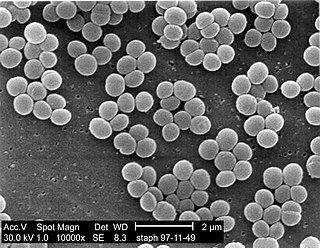Related Research Articles

Acidobacteriota is a phylum of Gram-negative bacteria. Its members are physiologically diverse and ubiquitous, especially in soils, but are under-represented in culture.

Thermus is a genus of thermophilic bacteria. It is one of several bacteria belonging to the Deinococcota phylum. Thermus species can be distinguished from other genera in the family Thermaceae as well as all other bacteria by the presence of eight conserved signature indels (CSIs) found in proteins such as adenylate kinase and replicative DNA helicase as well as 14 conserved signature proteins (CSPs) that are exclusively shared by members of this genus.
The Alicyclobacillaceae are a family of Gram-positive bacteria. All members of this family are aerobic and form endospores.
The Gemmatimonadota are a phylum of bacteria established in 2003. The phylum contains two classes Gemmatimonadetes and Longimicrobia.

Mycobacterium kansasii is a bacterium in the Mycobacterium genus. It is an environmental bacteria that causes opportunistic infections in humans, and is one of the leading mycobacterial causes of human disease after tuberculosis and leprosy.

Cronobacter sakazakii, which before 2007 was named Enterobacter sakazakii, is an opportunistic Gram-negative, rod-shaped, pathogenic bacterium that can live in very dry places, otherwise known as xerotolerance. C. sakazakii utilizes a number of genes to survive desiccation and this xerotolerance may be strain specific. The majority of C. sakazakii cases are adults but low-birth-weight preterm neonatal and older infants are at the highest risk. The pathogen is a rare cause of invasive infection in infants, with historically high case fatality rates (40–80%).

Staphylococcus is a genus of Gram-positive bacteria in the family Staphylococcaceae from the order Bacillales. Under the microscope, they appear spherical (cocci), and form in grape-like clusters. Staphylococcus species are facultative anaerobic organisms.
Algoriphagus is a genus in the phylum Bacteroidota (Bacteria).
Polynucleobacter is a genus of bacteria, originally established by Heckmann and Schmidt (1987) to exclusively harbor obligate endosymbionts of ciliates belonging to the genus Euplotes.
Pseudarthrobacter defluvii is a bacterium species from the genus Pseudarthrobacter which has been isolated from sewage from the Geumho River near Daegu, Korea. Pseudarthrobacter defluvii has the ability to degrade 4-chlorophenol.
Azospirillum is a Gram-negative, microaerophilic, non-fermentative and nitrogen-fixing bacterial genus from the family of Rhodospirillaceae. Azospirillum bacteria can promote plant growth.
Bhargavaea ginsengi is a Gram-positive, moderately halotolerant and non-motile bacterium from the genus of Bhargavaea which has been isolated from the roots of a ginseng plant in Beijing in China.
Kaistia adipata is a bacterium from the genus of Kaistia which has been isolated from soil near the Chung-Ju industrial complex in Korea.
Kaistia dalseonensis is a bacterium from the genus of Kaistia which has been isolated from river sediments from the Dalseo Stream in Korea.
Kaistia defluvii is a Gram-negative, aerobic and non-motile bacterium from the genus of Kaistia which has been isolated from river sediments from the River Geumho in Korea.
Kaistia hirudinis is a Gram-negative and rod-shaped bacterium from the genus of Kaistia which has been isolated from a leech from the Leech Breeding Station in Biebertal in Germany.
Kaistia soli is a Gram-negative, strictly aerobic and non-motile bacterium from the genus of Kaistia which has been isolated from a peat layer 1200 meter above sea level in Yongneup in Korea.
Reichenbachiella faecimaris is a bacterium from the genus of Reichenbachiella which has been isolated from tidal flat sediments from the Yellow Sea in Korea.
Thalassotalea is an aerobic and chemo-organo-heterotrophic genus of bacteria from the family Colwelliaceae which occur in the ocean and in sea ice.
Glutamicibacter creatinolyticus is a Gram-positive, non-spore-forming and aerobic bacterium from the genus Glutamicibacter which has been isolated from human urine in Japan.
References
- 1 2 Parte, A.C. "Kaistia". LPSN .
- ↑ "Kaistia geumhonensis Taxon Passport - StrainInfo". www.straininfo.net. Archived from the original on 2017-01-18. Retrieved 2017-01-16.
- ↑ "Kaistia geumhonensis". www.uniprot.org.
- ↑ "Details: DSM-18799". www.dsmz.de.
- ↑ Jin, L.; Kim, K. K.; Baek, S.-H.; Lee, S.-T. (3 December 2010). "Kaistia geumhonensis sp. nov. and Kaistia dalseonensis sp. nov., two members of the class Alphaproteobacteria". International Journal of Systematic and Evolutionary Microbiology. 61 (11): 2577–2581. doi:10.1099/ijs.0.028894-0. PMID 21131499. S2CID 206173125.